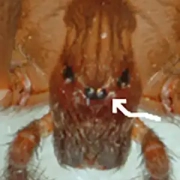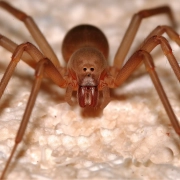Brown Recluse Spider
 The brown recluse spider is part of the genus Loxosceles. It is sometimes known as “fiddleback” spiders or “violin” spiders because of the violin-shaped marking on the top of the cephalothorax, which is the head and the thorax.
The brown recluse spider is part of the genus Loxosceles. It is sometimes known as “fiddleback” spiders or “violin” spiders because of the violin-shaped marking on the top of the cephalothorax, which is the head and the thorax.
The brown recluse spider has six eyes, all arranged in three pairs (sometimes a pair may be so close that they look like one eye rather than two). Their eyes are also their most noticeable feature, making it easy to identify a brown recluse spider.
Identify the Brown Recluse Spider
The violin-shaped marking is typically found only on more mature brown recluse spiders. The brown recluse ranges from a light tan to a darker brown color, covering their entire body with thin hairs. The brown recluse spider is about 3/8 inches long and about 3/16 inches wide. Although the male spider is somewhat smaller in body length than females, their leg span is usually the same length.
If there is more than one color on the legs, or if the legs are dark brown, or if there is more than one pigment on the abdomen, it is NOT a recluse. Note: spitting spiders (genus Scytodes) have a similar eye pattern but do not have the violin mark.
 The brown recluse spider is found throughout the Midwest and the southern central part of the United States. Brown recluse spiders are typically found outside in many different areas, such as under rocks or logs, woodpiles, dirt, or debris.
The brown recluse spider is found throughout the Midwest and the southern central part of the United States. Brown recluse spiders are typically found outside in many different areas, such as under rocks or logs, woodpiles, dirt, or debris.
It is very rare to find a brown recluse spider outside those areas. However, during the cooler months, it is not uncommon to find brown recluse spiders within the house, especially in basements, attics, closets, or anywhere else that is dry and warm.
During those months, the brown recluse will often go without food or water. It is nearly impossible to fully get rid of brown recluse spiders once they have become established in these areas of the home. The brown recluse does not spin a web to catch its food; instead, they hunt their prey, which usually consists of dead or alive insects.
The brown recluse is somewhat nocturnal, as they spend most daylight hours hidden within rocks or logs. They line these homes with webbing, later used for holding their egg sacs. If a brown recluse spider is seen during daylight hours, it usually has to do with the fact that they are hungry; otherwise, they stay hidden.
Our Brown Recluse Spider Bite section has some very graphic pictures of what happens when people are bitten by a BRS and pictures of the spider. Rick Vetter over at UC Riverside Dept of Entomology also has a page on Entomology – Brown Recluse Spiders. The agricultural extension service of the University of Tennessee has a brown recluse spider packet in pdf format that you may also find helpful.
Here is a quick test to determine if you may have a Recluse:
1) Has 3 pairs of eyes, one in front, one on each side.
2) Has Violin shaped marking
3) Legs must be one uniformly light-colored
4) Only one pigment on the abdomen
5) Fine hairs on legs, no spines
6) Body length is less than half an inch (3/8 usually)
Brown Recluse Spiders
Brown recluse spiders are not aggressive unless aggravated, which is like many other species of spiders. Some cases where they may bite is if they are trapped between skin and other surfaces or when putting on clothes that they are hiding in.
The brown recluse spider bite is often not even felt, which makes it very dangerous. Because of that, it is extremely important to thoroughly shake out clothing before putting it away to ensure that no hidden spiders can bite. In some cases, the bite is noticed immediately because of immense pain. For others, it can take several hours before the bite is noticed. The reaction to the bite depends on how much venom is injected.
The only deaths reported from a brown recluse spider bite have been with children under seven. However, the brown recluse, along with the black widow spider, is one of four species of spiders that is dangerous to humans.
If bitten by a brown recluse spider, the victim must immediately seek medical attention. If you can do it without risk, capturing the spider and bringing it in could help ensure accurate identification. Taking a picture is much safer, but only if there is no risk of being bitten.
More about the Brown Recluse Spider Bite